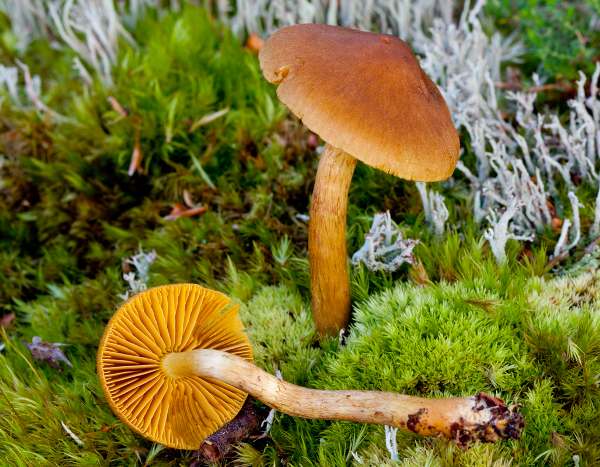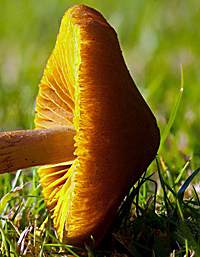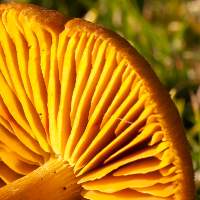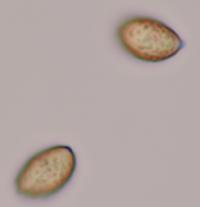Cortinarius croceus (Schaeff.) Gray - Saffron Webcap
Phylum: Basidiomycota - Class: Agaricomycetes - Order: Agaricales - Family: Cortinariaceae
Distribution - Taxonomic History - Etymology - Toxicity - Identification - Reference Sources

In the difficult Cortinarius group of fungi Cortinarius croceus is just one of several orange-brown capped species. To be anything like certain you need to see young and mature specimens of the Saffrom Webcap and to assess spore size, ornamentation and other microscopic characters.
Distribution
Cortinarius croceus is fairly common in Britain and Ireland and is recorded also from many parts of mainland Europe.
The Saffron Webcap is reported to be very useful as a source of dye for colouring fabrics.
Taxonomic history
In 1753 German naturalist Jacob Christian Schaeffer described the Saffron Webcap and gave it the scientific name Agaricus croceus. (In the early days of fungal taxonomy almost anything with gills was placed in a gigantic Agaricus genus, now slimmed down to more manageable proportions as many of its former residents have been moved into more appropriate accommodation in new genera.) It was British mycologist Samuel Frederick Gray (1766 - 1828) who in 1821 transferred this species to the genus Cortinarius, thereby establishing its currently-accepted scientific name Cortinarius croceus.
Synonyms of Cortinarius croceus include Agaricus croceus Schaeff., Cortinarius cinnamomeobadius Rob. Henry, Dermocybe cinnamomeobadia (Rob. Henry) M.M. Moser, and Dermocybe crocea (Schaeff.) M.M. Moser.
The vast genus Cortinarius is subdivided by many authorities into subgenera, and Cortinarius croceus belongs to the subgenus Dermocybe.
Etymology
The generic name Cortinarius is a reference to the partial veil or cortina (meaning a curtain) that covers the gills when caps are immature. In the genus Cortinarius most species produce partial veils in the form of a fine web of radial fibres connecting the stem to the rim of the cap.
The specific epithet croceus comes from Latin and means coloured like saffron (the golden-yellow pollen of crocuses).
Toxicity
This mushroom is recorded by some authorities as 'poisonous'. Because several of the webcaps are known to be deadly poisonous (and some research even suggests that all Cortinarius species may contain at least small amounts of the toxins concerned), in our opinion webcaps should never be gathered for eating.
Identification guide
 |
CapThe finely felty convex, often slightly umbonate caps of Cortinarius crceus are 2.5-5.5cm in diameter and vary in colour from yellow-brown to reddish-brown. A short-lived yellowish cortina joins stem to cap rim of young fruitbodies. concealing the immature gills. |
 |
GillsAdnate or emarginate with a slightly decurrent tooth, moderately to closely spaced; at first yellow, mustard or light orange becoming more orange-brown as the spores mature. The gills are probably the most distinctive and consistent feature of this very variable webcap. StemThe longitudinally fibrillose stem is 3-8cm long and 3-8mm in diameter, cylindrical; solid when you, becoming hollow with age; the surface is covered with yellow or yellow-brown veil remnants.. |
 |
Basidia27-35 x 7-9µm; four-spored. SporesOvoid or slightly amygdaloid (almond shaped); moderately to strongly verrucose (with a roughened surface), 6.5-9 x 4.5-5.1µm. Spore printRusty-brown. |
Odour/taste |
Odour strongly sweet and unpleasant; some say like camphor. Taste reported to be bitter or acidic and unpleasant, but it is generally considered unwise to taste any Cortinarius species because several of them are deadly poisonous. |
Habitat & Ecological role |
Mycorrhizal, in coniferous and mixed woodland, most often with pines, spruces or birches but occasionally with other broadleaf trees. |
Season |
August to November in Britain and Ireland. |
Similar Species |
Cortinarius uliginosus is similar but generally occurs in wetter habitats. |
Reference Sources
Fascinated by Fungi, 2nd Edition, Pat O'Reilly 2016, reprinted by Coch-y-bonddu Books in 2022.
Funga Nordica, Henning Knudsen and Jan Vesterholt, 2008.
British Mycological Society, English Names for Fungi
Dictionary of the Fungi; Paul M. Kirk, Paul F. Cannon, David W. Minter and J. A. Stalpers; CABI, 2008
Taxonomic history and synonym information on these pages is drawn from many sources but in particular from the British Mycological Society's GB Checklist of Fungi.
Acknowledgements
This page includes pictures kindly contributed by David Kelly.
Fascinated by Fungi. Back by popular demand, Pat O'Reilly's best-selling 450-page hardback book is available now. The latest second edition was republished with a sparkling new cover design in September 2022 by Coch-y-Bonddu Books. Full details and copies are available from the publisher's online bookshop...

